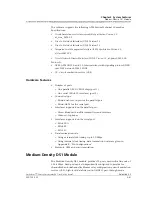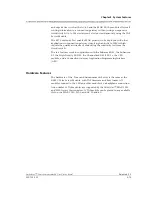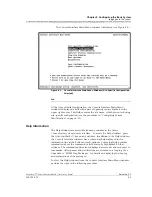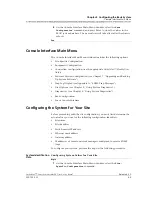
255-700-025
3-75
PacketStar
™
Access Concentrator 60 User Guide
, Issue 1
Release 6.3.0
Chapter 3 System Features
DSP2 Voice Server Module
on-hook to off-hook, where the on-hook state last between 300 msec and
1000 msec. This feature is compliant with TIA/EIA-464-B Requirements for
Private Branch Exchange (PBX) Switching Equipment.
The DSP2A, DSP2B and DSP2C modules offer limited support to the Caller ID
feature, but only with a specialized configuration setup with the Enhanced
DS1 Module. See
“PacketStar
™
PSAX Access Concentrator Caller ID Application
Note”
(Document No. 255-700-006) for instructions on configuration.
Hybrid A, B and C
Mode Configurations
You may configure the 32 interfaces on the module in any combination of A,
B, or echo cancellation modes that you need.
Previous Version
Compatibility
With software releases 6.2.0 and subsequent, modules DSP2A, DSP2B, and
DSP2C will re-route connections made to failed DSPs. For modules previous
to release 6.2.0, the DSP2A and DSP2B onboard processor cannot detect chip
failures. The CPU can route connections that require DSP resources only if
compatible DSP resources are available. For example, a connection
configured for G.168 echo cancellation will not re-route to a DSP configured
for G.165 echo cancellation.
Soft Permanent
Virtual Circuit
Support
With Release 6.3.0, the DSP2C can offer its voice and data processing
capabilities in an SPVC over PNNI, ATM UNI, or IISP link.Up to 247
connections are configurable on a CE-to-ATM VCC PVC connection. See
Chapter 7 of the DSP2A, DSP2B, and DSP2C Module User Guide for
instructions and configuration restrictions.
Voice Processing
The DSP2C Voice Server module can perform the following types of voice
processing:
•
DSP2CNear-end echo cancellation only (G.165 and G.168 on DSP2A
mode and DSP2B mode; G.168 in echo cancellation mode)
•
Facsimile (fax)/modem call sequence detection
•
Voice compression and decompression, G.726 (DSP2A mode) and G.729
(DSP2B mode)
Silence Suppression
Comfort Noise
Silence suppression saves bandwidth when there is no voice activity, and
improves the user’s comfort by generating comfort noise when the line is
silent. When there is no voice activity, the comfort noise feature samples the
background noise and sends a few cells across the ATM link. These cells are
fed into a white noise generator on the far end. The far end regenerates the
background noise so that the user knows the connection is still active. The
background noise level is updated every 5 seconds provided the background
noise does not change. If the background does change, there is an activity
burst and the background noise level is updated every 20 msec, until a steady
state condition occurs again.






























